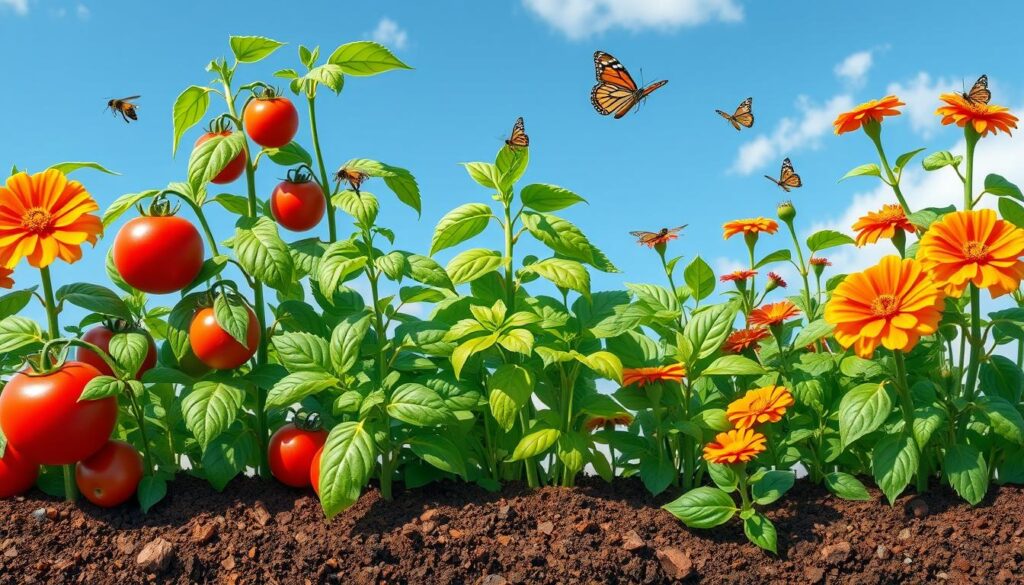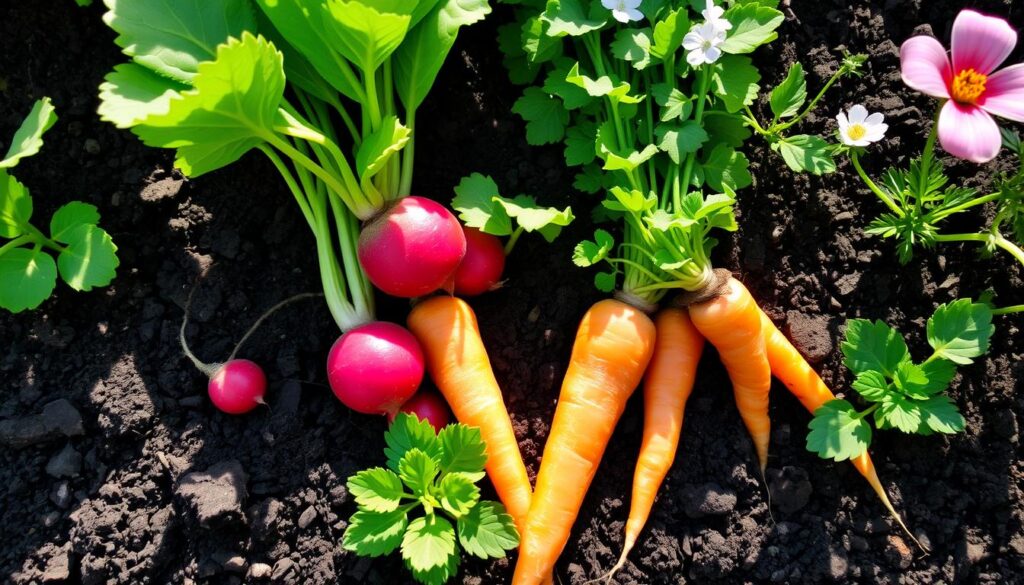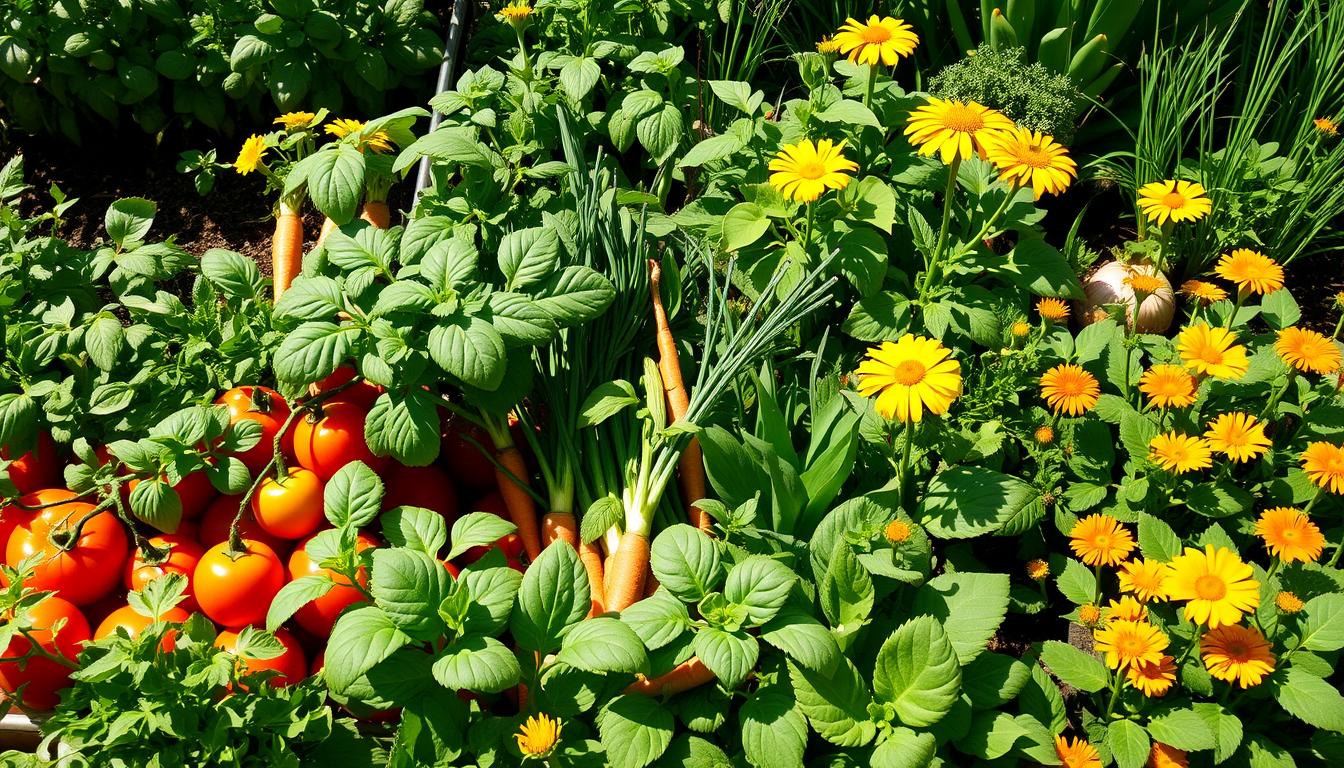I’ve learned a lot about companion planting, which is about pairing veggies to make your garden better. This guide will show you how to pick the right plants together. You’ll see how they help each other grow and keep pests away.
By using companion planting, your garden will be healthier and more productive. You’ll get to enjoy a big harvest every year. It’s all about working with nature to make your garden flourish.
Key Takeaways
- Companion planting is the strategic placement of different plants to create mutually beneficial relationships.
- Certain vegetable pairings can enhance the growth, flavor, and pest resistance of your garden.
- By understanding the principles of companion planting, you can create a more productive and sustainable garden.
- Companion planting can help reduce the need for chemical pesticides and fertilizers, promoting organic gardening practices.
- Exploring traditional and modern companion planting techniques can inspire you to create a thriving, low-maintenance garden.
What is Companion Planting?
Companion planting is a gardening method that places different plants near each other. This old practice uses natural plant relationships to help growth, fight pests, and boost garden health. Knowing about companion planting’s benefits and history helps gardeners make their gardens thrive.
Definition and Benefits
Companion planting is about pairing plants that help each other. By grouping these plants, gardeners get many advantages, such as:
- Improved pest control through natural deterrents and pest-confusing plant combinations
- Enhanced soil health and nutrient cycling from the diverse root systems and plant-microbe interactions
- Higher crop yields due to increased pollination, nutrient availability, and reduced competition
- A more resilient, low-maintenance garden ecosystem that requires fewer external inputs
History and Traditional Practices
The roots of companion planting lie in traditional farming methods of indigenous cultures worldwide. For ages, farmers have used plant relationships to grow more diverse, productive, and sustainable gardens. The Three Sisters method of Native Americans and Asian and African polycultures are examples of this.
Now, modern gardeners and small farmers are using companion planting again. They aim to create gardens that are resilient and low-input, like natural ecosystems.
Vegetables That Thrive Together
Gardening is all about “companion planting.” It helps certain vegetables grow better together. By knowing how different vegetables work together, gardeners can make their gardens more productive and peaceful. Let’s look at some vegetables that go well together and why.
Tomatoes and basil are a classic pair. They look great together and help each other out. Basil keeps pests away from tomatoes. Tomatoes give basil the shade and support it needs to grow well.
| Vegetable Pairing | Benefits |
|---|---|
| Tomatoes and Basil | Pest repellent, shading and support |
| Corn, Beans, and Squash (Three Sisters) | Nitrogen fixation, shade, and soil improvement |
| Radishes and Carrots | Pest and weed control, soil aeration |
| Marigolds and Tomatoes | Natural pest repellent, soil enrichment |
| Cucumbers and Sunflowers | Shade provision, support, and beneficial insects |
| Brassicas and Aromatic Herbs | Pest deterrence, soil improvement |
The “Three Sisters” method is another great example. It involves growing corn, beans, and squash together. Corn supports the beans, which fix nitrogen for the corn and squash. Squash’s wide leaves keep weeds down and hold moisture.
Knowing about these vegetable pairs can make your garden better and more sustainable. Whether you’re new to gardening or have been doing it for years, using these tips can help you grow a healthy, eco-friendly garden.
Companion Planting Guide: Vegetables That Grow Well Together
Creating a great vegetable garden is like art. Companion planting is the secret to making it work. This guide will show you the best ways to pair vegetables for a garden that’s both beautiful and productive.
Companion planting is all about how different vegetables help each other. By placing them wisely, you can make your garden grow better, keep pests away, and create a balanced ecosystem. Let’s explore the companion planting guide and find out which vegetables are meant to grow together.
Complementary Combinations
Pairing plants that help each other is key in vegetable companion planting. Here are some great optimal vegetable pairings to try:
- Tomatoes and basil: A classic duo that not only looks beautiful but also helps repel pests and improve flavor.
- Carrots and radishes: These root vegetables work together to deter pests and loosen the soil for each other’s growth.
- Beans and corn: The “Three Sisters” of Native American agriculture, these companions provide mutual support and nitrogen-fixing benefits.
By arranging your vegetables smartly, you can make a garden that grows well with little effort. The trick is to match plants based on their needs and characteristics.
| Vegetable Pairing | Benefits |
|---|---|
| Tomatoes and basil | Pest repellent, flavor enhancement |
| Carrots and radishes | Pest control, soil improvement |
| Beans and corn | Mutual support, nitrogen fixation |
Use the companion planting guide to make a garden that’s easy to care for and works with nature. By choosing the right plant pairs, you’ll get lots of food and enjoy a garden that looks great.

Tomatoes and Basil: A Classic Combo
The pairing of tomatoes and basil is a perfect example of companion planting. These plants work well together, helping each other grow and taste better. Let’s see why this tomato-basil companion planting is so great.
Why They Work Well Together
The benefits of tomato-basil pairing come from how they grow and interact. Basil’s scent keeps pests like aphids and whiteflies away from tomatoes. At the same time, tomatoes give basil the shade and support it needs.
Together, they make each other taste even better. The basil’s flavor brings out the sweetness in tomatoes.
To get the most out of this duo, plant them close together in your garden. Place basil around the tomato plants for a beautiful and helpful setup.
“The classic pairing of tomatoes and basil is a match made in heaven for the home gardener.”
Learning about tomato-basil companion planting and its benefits helps you grow a garden that’s both healthy and delicious. It shows the power of choosing the right plants to grow together.
Corn, Beans, and Squash: The Three Sisters
The “Three Sisters” method is a traditional Native American way to grow corn, beans, and squash together. It’s a great lesson for today’s gardeners and those interested in sustainable farming.
In a Three Sisters garden, each plant helps the others. Corn gives beans a place to climb. Beans help the soil by adding nitrogen. Squash keeps the ground cool and moist, stopping weeds.
- Increased crop yields in a small space
- Reduced need for fertilizers and pesticides
- Enhanced soil health and biodiversity
- Preservation of traditional agricultural practices
Gardeners can make a self-sustaining garden like the Three Sisters. This method is a smart choice for those who want to avoid using lots of chemicals. It’s a great way to grow food in a way that’s good for the planet.
| Crop | Role in the Three Sisters |
|---|---|
| Corn | Provides a sturdy structure for bean vines to climb |
| Beans | Fix nitrogen in the soil to nourish the other plants |
| Squash | Shade the ground, helping to retain moisture and suppress weeds |
The Three Sisters method is more than just a way to grow food. It shows how important it is to connect with nature and our heritage. By using this method, gardeners can respect the traditions of indigenous people and help make our planet a better place.
Radishes and Carrots: Root Vegetable Companions
Radish-carrot companion planting offers many benefits. These two vegetables work well together. They fight pests and weeds.
The benefits of radish-carrot pairing are clear. It’s a great choice for any garden.
Pest Control with Radishes and Carrots
Pest control with radishes and carrots is a big plus. Radishes keep away aphids and cucumber beetles. Carrots hide the radish scent, making it hard for pests to find them.
- Radishes repel aphids, cucumber beetles, and other garden pests
- Carrots help mask the scent of radishes, making it harder for pests to find them
- The combination of radishes and carrots creates an effective natural pest control system
Planting radishes and carrots together helps fight pests. It cuts down on chemical use. This makes gardening more eco-friendly.
| Pest | Radish Impact | Carrot Impact |
|---|---|---|
| Aphids | Repels | Masks scent |
| Cucumber Beetles | Repels | Masks scent |
| Carrot Flies | Repels | Masks scent |
Radishes and carrots are a strong team against pests. They’re perfect for a healthy garden.

Marigolds and Tomatoes: Natural Pest Repellents
Gardeners have long used marigolds to keep pests away from their crops. These vibrant flowers are a big help when planting tomatoes. Their strong scent can keep away pests that harm tomatoes, making them great for natural pest control with marigolds.
Marigolds are good at keeping aphids, whiteflies, and nematodes away from tomatoes. These pests can harm tomato plants a lot. The smell of marigolds confuses and keeps these pests from tomatoes. Also, marigolds’ thick growth acts as a barrier, making it hard for pests to reach tomatoes.
Marigolds do more than just keep pests away. They also help the soil by loosening it and improving drainage for tomatoes. Plus, their bright colors make the garden look cheerful and welcoming.
| Benefits of Marigold-Tomato Companion Planting | Details |
|---|---|
| Natural Pest Control | Marigolds’ strong scent repels common tomato pests like aphids, whiteflies, and nematodes. |
| Soil Improvement | Marigolds’ deep root system helps to loosen and aerate the soil, improving drainage and nutrient absorption for tomato plants. |
| Visual Appeal | The vibrant colors of marigolds can add an eye-catching and cheerful element to the vegetable garden. |
Marigolds and tomatoes together are a great choice for gardeners. They use marigolds’ natural pest-repelling to get a good tomato harvest. This way, gardeners can enjoy a beautiful and healthy garden.
Cucumbers and Sunflowers: Beneficial Neighbors
The pairing of cucumbers and sunflowers might seem odd at first. But, it’s a perfect match for gardeners. The tall sunflowers give shade and support to the climbing cucumber vines. This combo helps both plants grow stronger and healthier.
Sunflowers act as a natural trellis for cucumbers. This keeps cucumbers from touching the ground. It also helps control the temperature and moisture around the plants. The shade from sunflowers is especially helpful in hot summers, protecting cucumber leaves from burning.
The cucumber-sunflower pairing also keeps pests away. Sunflowers’ strong scent can repel aphids and cucumber beetles. Meanwhile, cucumbers can hide the scent of sunflowers, making them less appealing to insects.
“Companion planting is a time-honored tradition that can bring many benefits to the garden, and the partnership between cucumbers and sunflowers is a prime example.”
By using the special traits of these plants, gardeners can create a symbiotic relationship. This relationship boosts the health and yield of their vegetable garden. The cucumber-sunflower combo offers more than just shade and support. It’s a great choice for gardeners wanting to make the most of their space and avoid chemicals.
Brassicas and Aromatic Herbs: Protection from Pests
As a gardener, I’ve found that pairing brassica crops with aromatic herbs is a game-changer. Plants like broccoli, cabbage, and kale benefit from being near rosemary, thyme, and sage. These herbs not only make your veggies taste better but also keep pests away naturally.
The strong smells from these herbs can keep pests like cabbage moths, aphids, and cabbage worms away. By planting herbs next to your brassicas, you create a barrier. This barrier confuses and repels pests, protecting your plants without harsh chemicals.
Also, these herbs attract good bugs like ladybugs and lacewings. These beneficial insects eat pests that harm brassicas. This creates a balanced garden ecosystem. It means you don’t need to constantly fight pests.



Leave a Reply